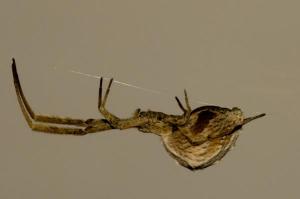Researchers in the Department of Civil and Environmental Engineering at the MIT Research Institute have discovered that the strength of biological materials, such as spider webs, lies in the particular spatial arrangements of structural proteins

Researchers in the Department of Civil and Environmental Engineering at the MIT Research Institute have discovered that the strength of biological materials, such as spider webs, lies in the specific spatial arrangements of structural proteins, which contain clusters-small regions of weak hydrogen bonds that work together to resist the force exerted on them and dissipate the energy absorbed within them.
This structure causes the lightest natural materials to be as strong as steel, even though the "glue" that holds them together, such as in spider webs, is hydrogen bonds that are a hundred to a thousand times weaker than the other chemical bonds found in metals and other covalent materials. Based on theoretical models and large-scale simulations performed on supercomputers, this new insight into the relationship between the strength of the natural material and the spatial arrangement of the proteins that make it up will allow engineers to develop modern materials that are light and strong, similar to spider webs.
The research could also affect the field of muscle tissue and the amyloid fibers found in brain tissue. "Our hope is that by understanding the atomic mechanisms that lead to material strength we will be able, in the near future, to establish guidelines that will lead to the synthesis of modern efficient materials," says Professor Markus Buchler, the principal investigator of the development.
In an article published on 13.02.2008 in the online issue of the journal "Nano Letters", the researcher and his students explain how they used atomic models to demonstrate how aggregates of three or four hydrogen bonds that joined together short beta strands in a structural protein were unraveled at the same time and not in a different way Phases when mechanical pressure was applied to the above protein. This situation allows the protein to absorb more energy than a situation where the strands were connected by only one or two bonds. Miraculously, these small clusters of hydrogen bonds could absorb more energy than longer beta strands held together by many hydrogen bonds. "The use of only one or two hydrogen bonds to build a protein provides very little mechanical strength, because the bonds are very weak and "break" easily," says the researcher.
However, the use of only three or four hydrogen bonds leads to strength that equals and even exceeds the strength of many metals. Using more than four ties actually leads to the weakening of the structure. Hence the maximum strength has three or four hydrogen bonds.” After the observation that the priming of these clusters of hydrogen bonds within the protein occurs simultaneously, the researchers wanted to know why the bonds break in small clusters, even in long strands connected by many hydrogen bonds. They used the laws of thermodynamics to explain the phenomenon. Their paper explains how the external force changes the anthropic energy of the system and leads to the breaking of the hydrogen bonds. By calculating the energy needed to initiate the priming process of the protein strands, they showed that the addition of hydrogen bonds on longer surfaces does not increase the strength of the material. "You just get long chains of beta-strands with weak bonds that don't contribute to the overall strength," claims the lead researcher. "But the stress material that has a spatial structure in which there are many short beta-strands connected together by three or four hydrogen bonds can provide greater strength than that of steel.
In metals, the energy will be absorbed directly by stronger bonds, called metallic bonds, until they break one by one. In proteins, the situation is more complex due to the anthropic flexibility of the chains and the cooperative nature of the hydrogen bonds." Structural proteins often contain beta-sheets, regions of strands or short segments stacked on top of each other, each just the right length to form three or four hydrogen bonds that hold them together from top to bottom. Such an arrangement is the most characteristic of all beta-type structural proteins, including those that make up the muscle tissues.
This correlation of spatial arrangement common to all beta-surfaces - one of the two main structures in proteins - implies that the structural strength of the protein is a very important evolutionary motive behind its physical design. The researchers found the same behavior in similar small clusters present in structural proteins of alpha-helices, the second most important structure in proteins, but had not yet studied these structures in more detail. On the other hand, synthetic materials composed of steel or other metals contain completely different crystal structures connected together by strong metallic bonds. Since these materials are highly compressed, and heavier as a result, they consume a lot of energy in their preparation and transportation from place to place. "Metals are made of stronger bonds and therefore a stronger force is required to break them," says the researcher.
"However, the crystal lattice of the metal structure is never perfect - it contains defects that actually seriously reduce the strength of the metal. When you load the metal the defect can increase and cause the development of cracks and structural fractures. In the beta-surfaces of proteins, the domain nature of the hydrogen-bonding clusters helps distribute the excess energy evenly without affecting the overall strength of the material. This fact faithfully presents the wisdom and efficiency inherent in natural materials."

One response
Lovely 🙂 It also explains the strength as well as the flexibility. :))